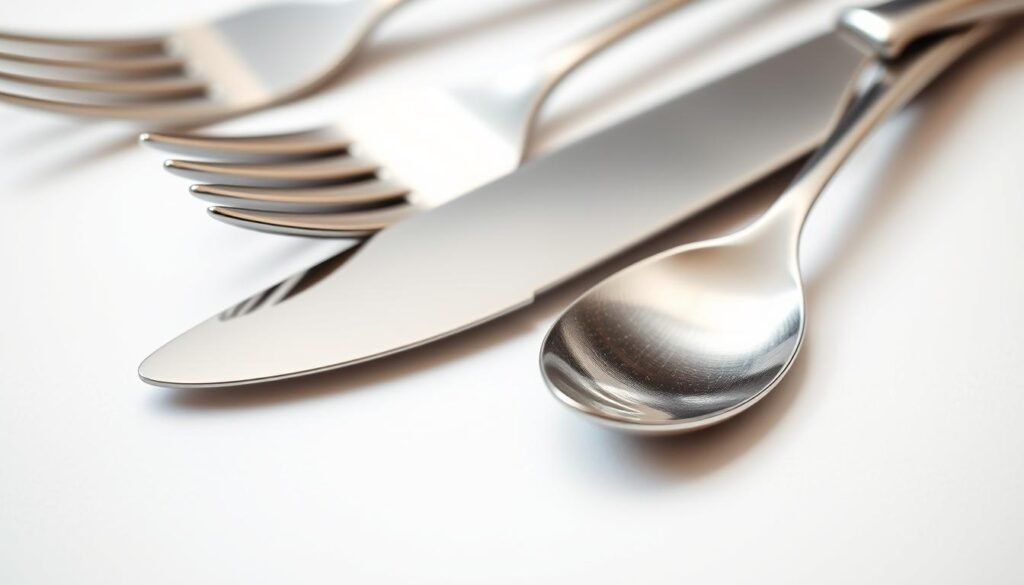Stainless steel is a popular material used in various household and kitchen items, including flatware and cutlery. Its durability and resistance to corrosion make it a preferred choice for many consumers.
The quality of stainless steel is determined by its composition, particularly the percentages of chromium and nickel. These elements play a crucial role in enhancing the material’s corrosion resistance and appearance.
When it comes to selecting the right stainless steel grade for your needs, understanding the differences between various types is essential. This guide will explore the key differences between 18/0 and 18/10 stainless steel, helping you make informed decisions for your kitchen and household needs.
Understanding Stainless Steel Grades
Understanding the nuances of stainless steel grades is crucial for selecting the right material for specific applications. Stainless steel is not a single entity but a family of alloys with varying compositions and properties.
What the Numbers Mean
The numbers associated with stainless steel grades, such as 18/0 and 18/10, refer to the percentage of chromium and nickel in the alloy. The first number represents the percentage of chromium, while the second number indicates the percentage of nickel.
Chromium content is critical as it forms a passive layer that protects the steel from corrosion. A minimum of 10.5% chromium is required for steel to be classified as stainless steel.
| Grade | Chromium Content (%) | Nickel Content (%) |
|---|---|---|
| 18/0 | 18 | 0 |
| 18/10 | 18 | 10 |
The Role of Chromium and Nickel
Chromium and nickel are key elements in stainless steel. Chromium creates a protective oxide layer that prevents rust and corrosion. Nickel enhances this layer, improving corrosion resistance, especially in acidic or salty environments.
Nickel also adds luster and shine to the steel, making it more aesthetically pleasing. Additionally, nickel improves the formability and strength of stainless steel.
The absence of nickel in 18/0 stainless steel makes it more susceptible to corrosion but also more affordable. Understanding these differences is essential for choosing the right grade for your needs.
18/10 Stainless Steel: Composition and Properties
With its unique composition, 18/10 stainless steel offers a blend of corrosion resistance, durability, and aesthetic appeal, making it a preferred choice for high-quality flatware and cutlery.
Chemical Makeup
The 18/10 stainless steel is primarily composed of 18% chromium and 10% nickel, with the remaining percentage consisting of iron and other trace elements. This specific blend is responsible for its superior resistance to corrosion and staining.
The high nickel content not only enhances its corrosion resistance but also contributes to its luxurious finish.
Key Characteristics
One of the standout features of 18/10 stainless steel is its ability to resist staining, pitting, and corrosion, especially when exposed to food acids. This characteristic makes it an ideal material for premium flatware and food preparation tools.
Durability and aesthetic appeal are also significant advantages, as it maintains its luster over time even with regular dishwasher use.
| Property | Description | Benefit |
|---|---|---|
| Corrosion Resistance | High resistance to staining and corrosion | Ideal for use with acidic foods |
| Aesthetic Appeal | Luxurious, mirror-like finish | Preferred for fine dining settings |
| Durability | Long-lasting with proper maintenance | Can become family heirlooms |
Advantages and Disadvantages
The advantages of 18/10 stainless steel include its superior corrosion resistance, ease of cleaning, and high-temperature handling capabilities. However, it also has some drawbacks, such as being more expensive than lower-grade stainless steel and having non-magnetic properties.

Despite the higher cost, its durability and longevity make it a worthwhile investment for many consumers. The non-magnetic property, while a limitation in certain applications, is generally not an issue for most household uses.
18/0 Stainless Steel: Composition and Properties
The 18/0 stainless steel grade is known for its affordability and is often used in budget-friendly cutlery and flatware. This type of stainless steel is a popular choice for various applications due to its unique combination of properties.
Chemical Makeup
18/0 stainless steel is primarily composed of 18% chromium and 0% nickel, making it a chromium-based stainless steel alloy. The absence of nickel gives it a distinct set of characteristics. The nickel-free composition makes it hypoallergenic, ideal for individuals with nickel allergies. The chromium content provides a level of corrosion resistance, although it is not as high as other grades with additional nickel.

Key Characteristics
One of the key characteristics of 18/0 stainless steel is its magnetic property, which can be advantageous in certain applications such as magnetic knife strips. It also has a more matte finish compared to higher nickel content grades. However, it is more brittle and prone to bending or breaking under stress, which can affect its durability.
The corrosion resistance of 18/0 stainless steel is adequate for many kitchen utensils and equipment but may not be sufficient in environments exposed to acidic foods or harsh chemicals. Regular maintenance is essential to prolong its lifespan.
Advantages and Disadvantages
The primary advantage of 18/0 stainless steel is its cost-effectiveness, making it an attractive option for basic flatware and kitchen tools. Its hypoallergenic nature is another significant benefit. However, it has several disadvantages, including reduced corrosion resistance and increased brittleness. It is also not ideal for welding due to its high melting point and tendency to distort.
In summary, 18/0 stainless steel offers a budget-friendly solution for various applications, particularly where nickel allergies are a concern. However, its limitations in terms of corrosion resistance and durability should be carefully considered.
Which is Better: 18/0 or 18/10 Stainless Steel?
When deciding between 18/0 and 18/10 stainless steel, it’s crucial to understand their differences in composition and performance. Both grades have their unique characteristics, advantages, and applications.
Head-to-Head Comparison
A direct comparison between 18/0 and 18/10 stainless steel reveals distinct differences in their properties. The key areas of comparison include corrosion resistance, durability and strength, and appearance and finish.
Corrosion Resistance
18/10 stainless steel offers superior corrosion resistance due to its higher nickel content. This makes it more suitable for applications exposed to corrosive environments.
Durability and Strength
Both 18/0 and 18/10 stainless steel exhibit high durability and strength. However, the presence of more nickel in 18/10 stainless steel can slightly affect its strength.
Appearance and Finish
The appearance of both grades can be quite similar, but 18/10 stainless steel tends to have a shinier finish due to its higher nickel content, which can be a deciding factor for aesthetic applications.
| Property | 18/0 Stainless Steel | 18/10 Stainless Steel |
|---|---|---|
| Corrosion Resistance | Good | Excellent |
| Durability and Strength | High | High |
| Appearance and Finish | Matte to Shiny | Shinier Finish |
Cost Considerations
The cost of 18/0 stainless steel is generally lower than that of 18/10 stainless steel, primarily due to the higher nickel content in 18/10. This cost difference can be a significant factor in choosing between the two for budget-sensitive applications.
Best Applications for Each Type
Understanding the best applications for each type of stainless steel is crucial for making an informed decision.
Kitchen Flatware and Utensils
18/0 stainless steel is commonly used for everyday knives, forks, and spoons due to its durability and cost-effectiveness.
Cookware and Food Preparation
18/10 stainless steel is preferred for cookware and food preparation utensils where corrosion resistance is critical.
Other Household and Industrial Uses
For outdoor applications and in environments exposed to moisture or corrosive substances, 18/10 stainless steel is the better choice. It’s ideal for outdoor furniture, grills, and garden tools.
Conclusion
The choice between 18/0 and 18/10 stainless steel ultimately depends on the intended application and budget. When comparing these two grades, it’s clear that 18/10 stainless steel offers superior performance, appearance, and longevity, making it ideal for premium flatware, cookware, and items that will be used frequently or exposed to challenging conditions.
On the other hand, 18/0 stainless steel remains a practical choice for those on a budget, in temporary living situations, or where nickel allergies are a concern. Regardless of the grade chosen, proper care and maintenance are crucial to extend the life of stainless steel items. This includes avoiding prolonged exposure to salt, harsh chemicals, and acidic substances, and drying thoroughly after washing to prevent water spots.
When purchasing stainless steel products, it’s essential to check the grade designation to ensure you’re getting the appropriate quality for your intended use and price point. The weight and balance of flatware pieces can also indicate quality, with 18/10 stainless steel typically offering a substantial, well-balanced feel that enhances the dining experience. For long-term purchases or potential heirlooms, investing in 18/10 stainless steel provides superior value through decades of use and maintained appearance.
